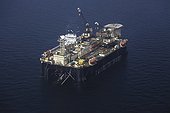Nord Stream: “The First Three Kilometres Are Laid”
- Construction started in Swedish waters; first gas deliveries planned in 2011
- One of three specialised pipelay barges is now laying the first section of the pipeline towards the Gulf of Finland
- 1,224-kilometre long natural gas pipeline to connect European gas grid to Russia’s large gas reserves
April 9, 2010 | Zug | Construction of the Nord Stream natural gas pipeline has started in the Swedish Exclusive Economic Zone of the Baltic Sea. The pipelay barge Castoro Sei began offshore pipe laying near the Island of Gotland and with a distance of 675 kilometres from the pipeline’s starting point near Vyborg, Russia, marking an important milestone for the Nord Stream project.
“The first three kilometres of the Nord Stream Pipeline are laid,” said Henning Kothe, Project Director, Nord Stream AG. “Now we are finally making our project a reality. During the permitting phase, we showed that we are planning a technically and environmentally safe project; now we will live up to our plans and create the infrastructure that will secure Europe’s gas supply for decades to come.” Since 2006, the Swiss-based consortium has thoroughly planned one of Europe’s largest infrastructure projects. When completed, the Nord Stream Pipeline will transport 55 billion cubic metres of natural gas a year to Europe.
Environmental Factors Play Important Role
Before Nord Stream could start constructing the first of its two pipelines, each of them with an inner diameter of 1.153 metres, the consortium underwent a permitting process involving all nine countries bordering the Baltic Sea. Detailed transboundary and national environmental impact assessments were carried out based on detailed studies of the Baltic Sea region. Nord Stream invested more than 100 million Euros in surveys and route planning. This led to the development of pipe-laying procedures and sequencing, as well as an environmental monitoring programme to meet safety and environmental requirements while enabling the construction vessels to work efficiently.
Three Specialised Pipelay Vessels
Throughout the project, a number of vessels will be used for different activities such as pipe supply, surveying, or anchor handling. Pipe laying itself will be carried out by three lay barges: Saipem’s Castoro Sei for most of the offshore construction, Saipem’s Castoro Dieci, near the German shore (from June 2010) and Allseas’ Solitaire in the Gulf of Finland (starting in September 2010). Each of these vessels is a floating factory: Continuously, concrete coated steel pipes, each about 12-metres long and weighing about 25 tonnes will be supplied from five stockyards located around the Baltic Sea. On board, pipes are bevelled and welded together to form the pipeline. Before they are lowered into their designated position on the seabed, each weld will be subjected to ultrasonic testing, millimetre by millimetre.







